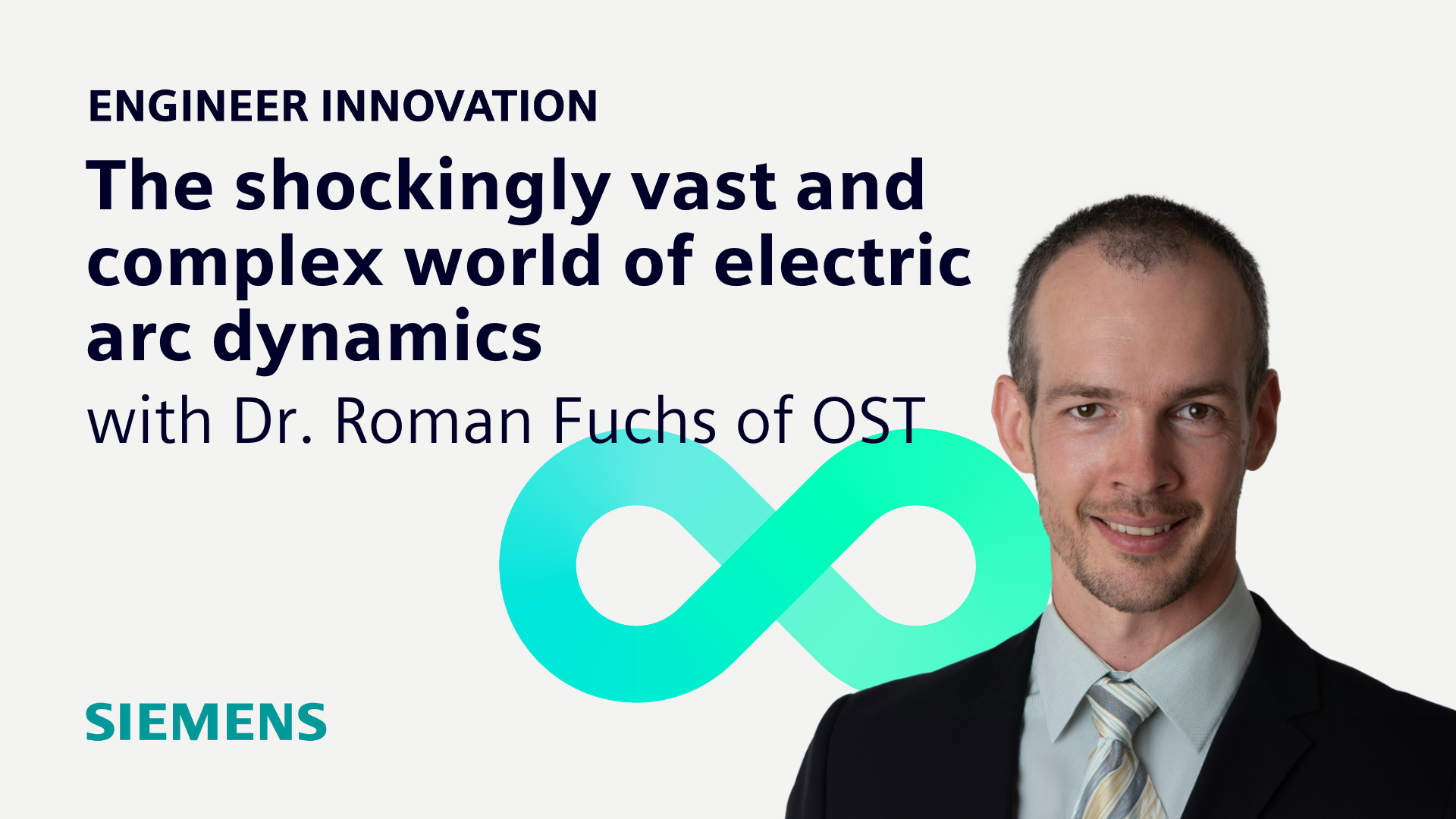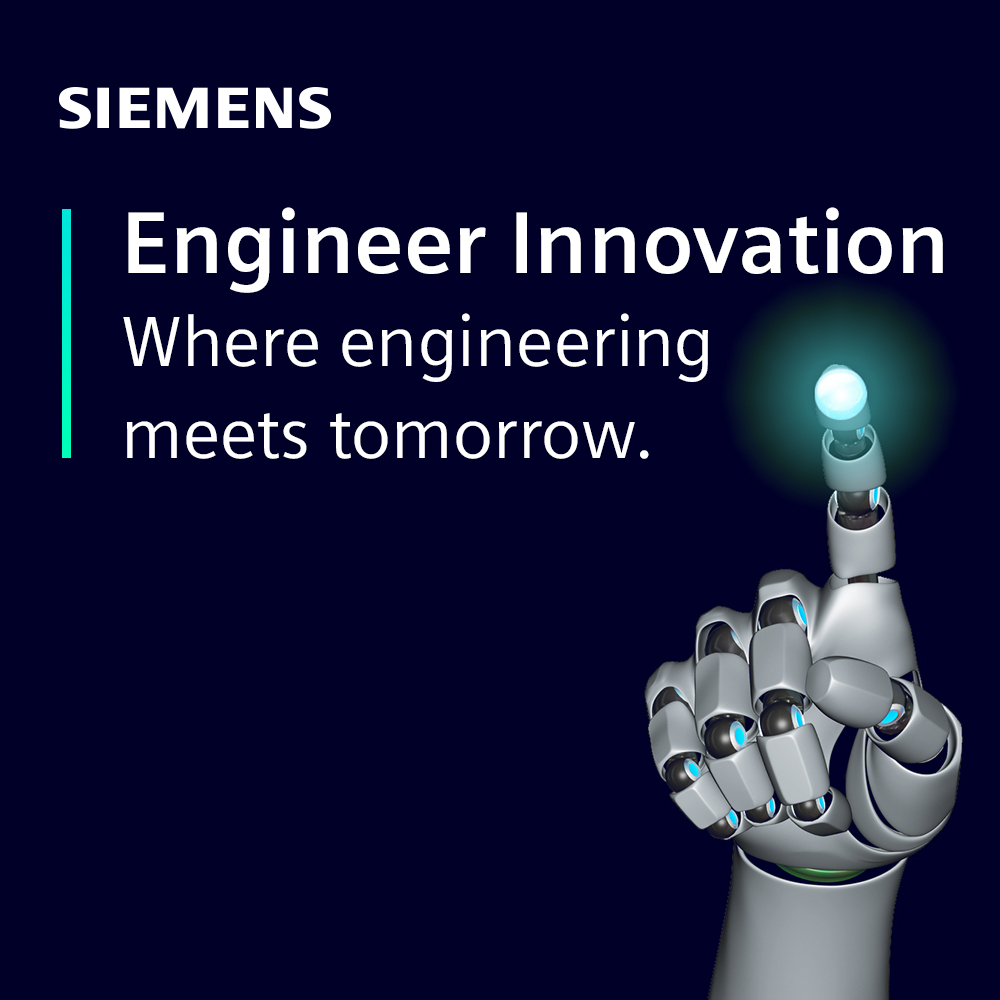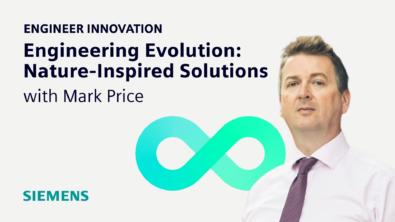The shockingly vast and complex world of electric arc dynamics

Guest Dr. Roman Fuchs of OST
Listen on Apple
Listen on Spotify
Show Notes
In this episode, we’re joined by Dr. Roman Fuchs, a Lecturer at OST. Dr. Fuchs talks about electric arc simulations, their role in electrical engineering and their impact on safety and efficiency in power systems and electric vehicles. Learn about the latest advancements in simulation technology and how they are driving innovation.
Key Takeaways:
- Electric arc simulations help create safer and more reliable electrical systems.
- Understanding high- and low-voltage circuit breakers is key to designing efficient systems.
- Reducing the environmental impact of SF6 gas in high-voltage circuit breakers is important for sustainable engineering.
This episode of the Engineer Innovation podcast is brought to you by Siemens Digital Industries Software — bringing electronics, engineering and manufacturing together to build a better digital future.
If you enjoyed this episode, please leave a 5-star review to help get the word out about the show and subscribe on Apple or Spotify so you never miss an episode.
Watch on YouTube
Guest biographies and episode transcript
- Introduction to the complexities of electric arc simulations. (01:37)
- Exploring the challenges and innovations in electric vehicle switchers. (04:28)
- The difficulties in conducting experiments with electric arcs. (08:00)
- The importance of high-voltage circuit breakers. (12:27)
- Insights into the multi-physical nature of electric arc simulations. (18:25)
- Understanding the computational requirements for accurate simulations. (23:27)
- The transition from SF6 gas to sustainable alternatives in circuit breakers. (36:38)
[00:00:00] Chad Ghalamzan: from a software engineering point of view, and, typically don’t get to robust solutions.
[00:00:04] Roman Fuchs: so one solver is diverging and the other doesn’t keep up with the first one. And you should solve it as a one. fully coupled system, but no one does that. And that’s, where we started the research project and, delved into the details about that.
[00:00:19] Stephen: Hi, Chad, who’s your guest on this week’s exciting episode of the engineer innovation podcast?
[00:00:27] Chad Ghalamzan: Roman Fuchs, who’s here to talk about electric arcs and how complex it is to simulate them.
[00:00:33] Stephen: That’s kind of shocking.
[00:00:34] Chad Ghalamzan: I knew you were going to say that. Yeah, it’s a very difficult problem to simulate because it’s a true multi physics problem.
[00:00:41] Stephen: And what sort of applicationary, what sort of arcs are we talking about?
[00:00:45] Chad Ghalamzan: Roman is looking at all types, pretty much, vehicle, power generation,
[00:00:52] Chad Ghalamzan: you have in your fuse box at home. Really, it’s just the arc he’s interested in regardless of the size.
[00:00:59] Chad Ghalamzan: The
[00:01:00] Chad Ghalamzan: voltage involves, he’s looking at simulating these, they’re all follow the same basic principles when it comes to the physics, he’s just looking at the different applications and sizes
[00:01:12] Stephen: And you say
[00:01:12] Stephen: basic principles. We’ve already said, this is a really tough multi physics problem. And there’s not many people doing these kinds of simulations. I think it’s kind of a niche pursuit, which requires experts. So I think that’s why we’re talking to Roman.
[00:01:22] Chad Ghalamzan: Yeah. one of a handful of people that do it. And, you know, it’s a type of thing where you can’t really do tests or real experiments with this. It’s so dangerous. It’s so expensive. So simulation is the way, and he’s one of the pioneers in that area.
[00:01:36] Chad Ghalamzan: You
[00:01:36] Stephen: So I think that this podcast is always a place you should come if you’re interested in current affairs. So
[00:01:41] Stephen: let’s just say
[00:01:42] Stephen: danger, danger, high voltage, and let’s listen to this week’s exciting,
[00:01:45] Stephen: shocking episode of the engineer
[00:01:47] Stephen: Innovation Podcast.
[00:01:49] Chad Ghalamzan: Hello and welcome to this episode of the engineer innovation podcast. I’m joined today by Dr. Roman Fuchs. Hi, Roman. How are you?
[00:01:57] Roman Fuchs: I’m good. Thank you.
[00:01:58] Chad Ghalamzan: I’m good. Thanks. Why don’t you introduce yourself for our listeners?
[00:02:02] Roman Fuchs: why not? So I’m a researcher here at OST, University of Applied Science, Peter Easton, Switzerland, University, Institute of Energy Technology. And I’m here for 12 years. I started as a specialist for numerical simulations in fluid simulations, and then I embarked on electric arc simulations for the last decade.
[00:02:23] Roman Fuchs: And it’ll, interesting stuff and, this keeps me busy in the last few years. but I also did the doctorate on it.
[00:02:31] Chad Ghalamzan: So I think today we’re going to talk about electrical arcs. We’re gonna talk about electric arcs, a very important topic for me. The first thing that comes to mind when I think of an electrical arc is the lightning strike or some sort of large, connection, between two points, but that’s not the only type of electrical arcs that you’re looking into, if I understand correctly, right?
[00:02:52] Roman Fuchs: That’s right. There are so different, regimes of electric arcs. First, we should clarify that there is, electric arcs is a thermal plasma, whereas, most people are used to, non thermal plasmas in the light tubes. so we could here embark on a big discussion of what a plasma is, like our sun, and the interstellar plasma, which is a completely different topic.
[00:03:14] Roman Fuchs: And there is also in chemical reactions, you also often use plasmas, not arcs because they non thermal, but many, they are thermal, so hot. that means you’re talking about tens of kilocalvins on 10, 000 Kelvin and more, and everything will melt. And this is part of the fascinating thing, why they are studied.
[00:03:33] Roman Fuchs: And, on the other side, doing experiments is difficult because everything will melt. at another scale,generator circuit breakers, so the first switching device behind the big generator of a nuclear plant, for example, you don’t want to test that. So that’s why simulations are a big deal here.
[00:03:51] Chad Ghalamzan: Yeah, danger and safety and destruction, big part of what you’re trying to prevent here. So to test it, I would assume would incur all those things. So simulation is the key enabler to do this in a safe and responsible way. But, just to touch on my question again, when I, like I said, I think of more, maybe the older applications, but I guess recently power electronics in, electric vehicles has become another key area of study for arc simulation because of the number of components there and the battery,
[00:04:28] Roman Fuchs: Exactly. This is a very new topic for the last years that, has exploded himself. Um, so, um, assaid, the some point you shut off that car, let’s say in an accident or so, or even just, because turn it off, um, these switchers have to work and typically the battery becomes more powerful, by the years.
[00:04:53] Roman Fuchs: They have to, because we want to get to the same range as, as fuel powered cars. And so the, on the other hand, the switches shall not get larger. So you don’t want to have an extra trailer for that.
[00:05:07] Chad Ghalamzan: right? Yeah, of course.
[00:05:08] Roman Fuchs: so the, we are talking here on the size of, let’s say, a palm your hand. And, yeah, everything happens there in the same way.
[00:05:17] Roman Fuchs: Alright.
[00:05:18] Chad Ghalamzan: large scale, small scale, it’s all different sizes, all different causes for why the arcs will occur. When it comes to simulating them, does that make a difference?
[00:05:29] Roman Fuchs: Not at all. I would say, I should state that, the topic started, let’s say, in the 90s when I’m right. simulation of high voltage circuit breakers. That’s a bit easier than low voltage circuit breaker, which is a bit counterintuitive. let’s, explain that shortly. At high voltage, it doesn’t matter what happens at the surface of your electrodes, where the arc enters or exits from your solid, so we are talking there thousands of volts, whereas at in low voltage circuit breakers, it is very delicate what happens there at the surface and we could delve here what happens down to the micrometer scale and incurs an additional 20 volts.
[00:06:06] Roman Fuchs: at each, arc spot, and this is why your, switches, and in down in your cellar are working. That, that, that is part of the design in the low voltage circuit breaker. And this is only being simulated in by 2000 and later.
[00:06:18] Roman Fuchs: So I see about a decade later. And yeah, I would say nowadays it’s getting accessible, but still lots of, modeling. Decisions have to be taken here.
[00:06:28] Chad Ghalamzan: So it’s really just a question of high voltage versus low voltage, or is there other distinctions when you’re looking at arc simulation?
[00:06:36] Roman Fuchs: Okay, there’s middle voltage in between, but this is just another half scale. It’s more about what happens in this circuit breaker. As I already touched, everything will melt. and because they have metals there, you will have metal vapor and that, of course, changes all your Gas inside there. So you get gas mixture with that metal vapor.
[00:06:58] Roman Fuchs: someone shall cut them up with some material data of that, which is a separate topic. and then the electric arc, this is hot. So there are, as there are, the energy transport modes. There is conduction, convection and radiation. And it turns out radiation is the big part.
[00:07:15]
[00:07:15] Roman Fuchs: and here is another counterintuitive state. situation that, as soon as you have copper vapor there, it’s of course, it’s getting electrically more conductive, but also the radiative heat flux is increased. So in total, the gas is a bit colder than if you didn’t account for that.
[00:07:31] Chad Ghalamzan: So the copper particles heat up the air more.
[00:07:35] Roman Fuchs: not the other way around
[00:07:36] Chad Ghalamzan: The copper cools the air.
[00:07:38] Roman Fuchs: Yep. of course we are talking here. On the order of what’s happening at 10, 000 Kelvin or 8, 000 Kelvin. So given particular current, you get a different temperature profile out of that. But the peak temperature that will be lower if you include copper vapor, because of the increased heat transport the ambient.
[00:07:56] Chad Ghalamzan: So I think it’s important to take a second and break this down a bit because when. People hear electrical or electric arc simulation. They may just think we’re looking at the power looking at the electricity, but this is Really a multi physics simulation because you just mentioned for example The particles going into the air and how that’s affecting the temperature.
[00:08:15] Chad Ghalamzan: So maybe We should elaborate a little bit more in what goes into these types of simulation. Obviously, there’s the power, there’s electric component, there’s temperature, when you’re looking at the different circuit breakers that could be employed, depending on the application, are you looking at how they impact then not just the initial, incident, but what the, the mitigation effect of the circuit breaker does afterwards?
[00:08:39] Roman Fuchs: you have a circuit breaker that is opening, and by separating the context, you create this arc. that it’s the mechanics that is giving me the arc itself will not affect on the mechanics, so you can take that as a given. But then it’s the gas that is heated around it, and there’s a radiative heat flux to the nearby walls, and they also heat up and, yeah, they can be burned in different ways.
[00:09:01] Roman Fuchs: can be slowly melting or the radiative heat flux can go into the solid and so that means everything melts like. in the study, they got eruptions off this, wall and they melt in whole pieces. And so there’s a, as I said, it’s a multi physical thing and to appropriately model for that.
[00:09:23] Roman Fuchs: That’s another key. although I’m working on the topic, I can, I haven’t mastered that. always have to go for experts on that.
[00:09:30] Chad Ghalamzan: because it’s probably but you mentioned gas and we’ll get to that for a second, but just to maybe make sure I understand. So first and foremost, the idea is you need to stop the arc, you need to, break that connection. So that way, you’re not leading to more danger, more of a precarious situation.
[00:09:47] Chad Ghalamzan: But then What happens afterwards could still be dangerous if you don’t do it in a manner that controls the temperature and the surrounding equipment could still be destroyed or there could still be safety issues. So it’s a twofold problem we’re looking at first break, then make sure that by doing so we’re still not incurring damage or safety issues.
[00:10:07] Roman Fuchs: Yeah. Okay. I may talk to you again about the whole high voltage circuit breaker. So when they open, you have the arc there. And at some point you have by the power frequency, you get these so called zero current crossing. so the arc is gone, but just because of the power frequency, but it may be that the electrodes haven’t separated sufficiently from each other.
[00:10:28] Roman Fuchs: So the clearing distance is too short. And in a short time, you will see again, a high voltage across that short gap. But you still have a hot plasma there. So that means the arc can be reignited. So it has to be designed properly. Just at these zero currents where the current vanishes and by that the ohmic heating vanishes, all the hot gas is blown away.
[00:10:50] Roman Fuchs: So left with a clean cold gas. No, no copper vapor there. And then is separation distance must be sufficiently large to withstand that high voltage. And then we are talking, between dielectric failure or thermal failure of that gas or that circuit breaker again. So again, showing that these different aspects you have to think about.
[00:11:11] Roman Fuchs: It’s not only the heat, it’s also, the electromagnetic problem around it. And about the circuit. outside of your system. What’s what is given by your power free network ?
[00:11:21] Chad Ghalamzan: And you keep mentioning gas, but there are different types of circuit breakers, but do you only look at, gas based circuit breakers? And I presume that’s more for power generation or am I wrong?
[00:11:33] Roman Fuchs: Okay, there are different gases that are used. let’s go the other way around. First, there are other parts of some other circuit breakers you may use. I haven’t looked into those. I’m not too much into the topic from that, but it’s an economical decision you can take or design decision.
[00:11:49] Roman Fuchs: so let’s say,when you have these solid state circuit breakers, and not very much, not into that topic, but they have other design issues. be and they are on. What is their response time? There’s a gas circuit breaks as soon as as they are loaded or ready. They can always trigger because you never know when the issue happens.
[00:12:07] Roman Fuchs: that’s part of the design decisions you’re taking there. really just from the modeling part. You would have to ask someone else about the real difference of not using a gas circuit breakers but when we are talking about gas circuit breakers. Air is also a gas. Yeah, like low voltage circuit breakers.
[00:12:26] Roman Fuchs: They are mostly applied in air, so they are open to ambience, but they’re again to electric arcs. They are typically closed and sealed, and you have a particular gas there in, that must stay there for, let’s say, a decade, as long as the car is used. so yeah, you have different gases there.
[00:12:43] Chad Ghalamzan: And do you have a sense of how much damage? These incidents caused annually in terms of equipment destruction and any other figures in terms of fatality or safety for humans by having improper protection mechanism in place.
[00:13:01] Roman Fuchs: I don’t have the numbers, but you easily find examples on the web. you know,movies or even just pictures when someone manipulating at your,distribution, cabinet, where you have these sparks and, yeah, it’s, it can harm people. And there are, it was recently in the news that someone manipulated down in the cellar and got burned.
[00:13:21] Roman Fuchs: And this effect acts at millisecond level. and short and faster. There’s really no time to act somehow on that. you just get burnt. this is on people’s level. it can be destructive to the whole building in the end. you have such a high energy heat at the end, then it burns and in the, everything stands on fire.
[00:13:43] Roman Fuchs: That may happen. and when you look at, let’s say currently, It is the situation in the Ukraine and in such powers is power stations get bombed or so. And, the circuit breaker fails there. you have to shut down the whole part of the network. don’t have to supply of energy.
[00:13:59] Roman Fuchs: you’re here online, just ignore the consequences. And you don’t have any power there.
[00:14:04] Chad Ghalamzan: Yeah, there’s, is what we can quantify, but then there’s aspects, like you just mentioned, that are difficult to quantify, because of the lack of Proper circuit breakers, then you have to take other actions that are maybe economically damaging or Disruptive to people’s lives because like you said they have to cut the power then Maybe protecting the network, but it’s still a disruption to the people who have to deal with the power outage that ensues because of that what makes these so difficult to simulate?
[00:14:31] Chad Ghalamzan: Is it the multi physics aspect? Is it the Fast time as you mentioned in terms of this happens in milliseconds and you’re trying to capture a lot of phenomena in such a short time frame
[00:14:44] Roman Fuchs: Yeah, it’s, it’s multiple aspects there. So first, you have a gas there. So there is gas flow, which, as anyone in the field knows, acts on the order of the speed of sound 300 meters a second. of a kilometer second. whereas then the electromagnetic problem It’s not. instantaneous.
[00:15:00] Roman Fuchs: So on the order of, 300 kilometers a second speed of light. So you have a gap there, a factor of, 10, a thousand at least, isn’t it? and then the mesh requirements you need for the grid for the computational grid. On top of that, you have the. radiative, heat transfer problem, which is also instantaneous, on that scale.
[00:15:19] Roman Fuchs: And then when you go to the other side again, you have the power network, which is, yeah, very, you have 50 Hertz on, so 10 milliseconds and longer. so yeah, we have here a time scales problem, then we have a length scale problem. So your circuit breakers at home, they’re on the order of a hand.
[00:15:38] Roman Fuchs: Okay. So 10 centimeters. But when we go for the physical details, we should go down even to micrometers. yeah. So this is the time and space requirements. And then there is the computational requirements. I think you shouldn’t do such simulations on a small laptop.
[00:15:55] Chad Ghalamzan: Ideally not
[00:15:56] Roman Fuchs: Yeah, because it’s coupled. each of these fields I touched, they have their own, computational costs with. and in particular, the radiative heat transfer problem. That’s a delicate one. So theory, you could solve for the heat transfer problem for each frequency. So let’s say for each color that we see for red, blue, green for all these different frequencies.
[00:16:21] Roman Fuchs: But it’s the same computational cost as a one fluid flow problem. So for 100, 000 frequencies. You have to average that. down to a few dozens, maybe. but already this averaging is a, is another part of science, where international collaboration is required.
[00:16:39] Chad Ghalamzan: those frequencies with Yeah, which what’s the selection criteria there
[00:16:44] Roman Fuchs: a good question. so let’s go even more down on the length scale. Let’s go down to the atoms. when you add some energy to one, to an atom, then There are electrons around it and they gained that energy, at the beginning and at some point they, these atoms get ionized. So that means the electron leaves that atom, which is the ionization energy.
[00:17:08] Roman Fuchs: so you, you have that for oxygen, you have that for nitrogen organ, CO2 in air, and by that you can. Judge to the frequency. that is, very cut off these things. You can also look at the data and do a rough, rule of thumb there. There are different,averaging methods you can apply.
[00:17:27] Roman Fuchs: And, you can also say, okay, So there are two methods. Basically, there is so called blank mean and Rosalind mean, which are two extremes or limits of it. but there is also an intermediate version where you say, okay, the relevant length scale shall come into play. So why shall I account for some heat transfer on the order micrometers until it’s absorbed again by another molecule when my computational domain is on the order of ten centimeters?
[00:17:57] Roman Fuchs: And on the other hand, same, why shall I count for some radiative heat transfer that goes on the order of 100 meters until the energy is absorbed when my domain size is 10 centimeters? So you can do a renormalization on that, which is another field.
[00:18:13] Chad Ghalamzan: when we talk to people about their work and how they approach it, numerical simulation, it seems that they often try to approach it intelligently and say, what do I need to actually bring into my simulation if I’m looking at Let’s say, for example, a structural simulation and they wanna look at the durability.
[00:18:30] Chad Ghalamzan: They ask themselves, if they look at the system, what actually needs to be included in that particular simulation to, to get a useful, meaningful result. what features can ID feature or what can I ignore? But it’s the way you describe this problem, it’s almost like the exact opposite. It’s like you need to include so much detail and you’re looking at it at so many different levels to get an accurate understanding.
[00:18:53] Chad Ghalamzan: Of what’s occurring here, because of all the levels I mean you went down to the atomic level that’s you know, you’re looking at things on different size scales different time scales do you think that’s an accurate description of how complex this is compared to other types of multi physics?
[00:19:09] Chad Ghalamzan: Simulations that you know people are conducting
[00:19:12] Roman Fuchs: Maybe there is a way out of the problem because, if you do the experiment in the laboratory, you don’t get the repetitive results even in the laboratory. If you touch the solids once. They behave different, just because of the rem, what is left of your fingers, there at the solids.
[00:19:31] Roman Fuchs: So in that sense, I would say the simulations are as good, it’s already great if you have a result. And when you have really to go down for those tiny details. And we are really down into the topic. So that’s kind of a way out of the problem. but you asked what has to be input. So you need the gas flow.
[00:19:50] Roman Fuchs: What’s the, from classical mechanics analysis, you need them, for example, the motion, how the solids are opening, in between. and you need the circuit around it. So how is this power, electric power delivered to your circuit breaker? Are we talking like a low voltage circuit breaker when, when this is one is acting, the power network will not do anything about it.
[00:20:15] Roman Fuchs: It will just deliver the same voltage. On the other hand, when you have,your electric car and it might be quite relevant. What’s the voltage that is left in the battery. If it’s still keeping up with, what’s happening in the, this whole system. yeah, there are, these are the boundary conditions you have to deliver.
[00:20:33] Chad Ghalamzan: and is there anything about electric vehicles? and batteries that are completely different than what we’ve talked about so far in terms of how you approach those problems. As you said, it’s a more recent field of study in this area.
[00:20:46] Roman Fuchs: It’s a bit different in the sense that it’s, direct current. constant voltage level. Whereas at household applications, you have alternate current and there you have a power frequency and you 50 Hertz in 10 milliseconds. You have a zero crossing and you can, it helps in, in, in turning off till The electric current, whereas in, when you have this, direct current, voltage in an electric vehicle, you don’t have it, the only thing you can do is to lengthen the arc such a way that it is more, it must be sufficiently long to get sufficient voltage and to act against the battery, but you don’t have this frequency that helps you. so in that sense, it’s different, yes, and you should also account for, yeah, The charge that is left in your battery in the car or then in the laboratory what’s left in your capacitors. again, you can model on that or take a worst case scenario, but, yeah, it is, it’s another parameter you can look at it.
[00:21:41] Chad Ghalamzan: Now, you’ve mentioned a couple of times there was some counterintuitive results, or some counterintuitive assumptions that we make when it comes to these types of problems, that, when we do the simulation, we can see that they’re there. What we may not think. Is there any real life examples of.
[00:22:00] Chad Ghalamzan: This your work that you’ve been able to conduct and then. implement a system that was effective that you know at first was counterintuitive or didn’t think it would be the right solution but then ultimately it was the right way to introduce a circuit breaker or mitigating factor for an electric arc.
[00:22:20] Roman Fuchs: oh yes, there is. so for example, we had a collaboration once with, a lightning protection device for medium voltage power lines. And the laboratory observed two different modes. How did their breakers that is, like protection devices were operating, and we couldn’t simulate that until we realized, Oh, it’s dependent on
[00:22:44] Roman Fuchs: does the current come from the positive or negative side to current zero? And where are we at that position exactly? Okay. And how does it help if lightning that enters into the power network and we realized at some point we could solve it, but it’s here. the message is, we didn’t solve that with highly resolved simulations, but it was done on a paper and envelope calculation and simple differential equations that we looked at and solved it there first to get an intuition of this effect.
[00:23:17] Roman Fuchs: And then we did the simulations again. And then we saw what we wanted to have it. we also had to add another, let’s say, buffer. first, some of the explosive energy of the pressure wave is stored. And then after a few milliseconds later, it’s released back to this, where the arc was and washing away all the hot energy. and you can, design for that. What is the time delay? yeah.
[00:23:44] Chad Ghalamzan: like you reflected it back, you sent it back. Okay. And that, that dispersed the temperature that just disperse the heat.
[00:23:50] Roman Fuchs: And yeah, so first we, there was the arc creating an explosion, power, pressure shockwave. And then, of course, depending how far you’re reflecting wall is. can tune it for this, timescale until it’s back there again. it was, of these aspects where you just have to look at the system as a whole, and not just as one piece of it, and then trying to do a parameter studies and fiddle a bit around.
[00:24:15] Roman Fuchs: You have to look at it as a whole. And what do you need there?
[00:24:18] Chad Ghalamzan: sounds like it was very innovative approach to the problem.
[00:24:23] Roman Fuchs: Yeah. I wouldn’t say innovative, but, yeah,to clarify what’s happening there and to really understand what was the effect. And in the end we were able to, yeah, to explain where it was
[00:24:32] Chad Ghalamzan: So why this field of study? What is it about this field of study that appeals to you?
[00:24:37] Roman Fuchs: to me. so by training, I’m a mathematician and then I came into the fluid into the high performance simulation, the computational science, fluid simulations. And, yeah, we had the opportunity for a research project with industry where we embarked on electric arcs and, basically it just came to me.
[00:24:55] Roman Fuchs: but then I got fascinated about it because, so let’s say an electric arcs, as soon as they aren’t there, all is fine. You don’t want to see them, but as soon as you see them, it’s already too late. So this is on a phenomenological level, it’s more on the mathematical level, it’s because the, flow problem is a, very different from the electromagnetic problem.
[00:25:19] Roman Fuchs: we call it here, hyperbolic equations and elliptic equations, which are then completely different to be solved on the computer. As you may also know from multiphysics simulations, as soon as you split the problem into different parts and different solvers, that gets even worse, let’s say, from a software engineering point of view, and, typically don’t get to robust solutions.
[00:25:39] Roman Fuchs: so one solver is diverging and the other doesn’t keep up with the first one. And you should solve it as a one. fully coupled system, but no one does that. And that’s where we started the research project and, delved into the details about that. You would have the options there, but, again, when you go to the industrial applications, you fall back to that default solution that you split up the solvers and try to do the best as you can, what is available on the market.
[00:26:06] Chad Ghalamzan: And is there anything about Simcenter solutions that makes that research and approaching these problems easier and more accurate for you?
[00:26:17] Roman Fuchs: I’m working now with Simcenter for more than a decade. also with lots of support from the application specialists, when I embarked on the topic. what I really do is, of those 10 years, the graphical user interface is at a level where you can do everything by clicking.
[00:26:33] Roman Fuchs: You don’t have to program itself. And this is another story I’m usually telling. It’s not about the software that has to be good. It’s about the user interface. And, with other softwares. It is that you have to know one program language, and the second one, and the third, or, and putting all the pieces together, and with Simcenter it’s so easy by now, it wasn’t years ago, but by now it’s really easy, and you can do it in one interface, and that’s really great, and then coupling all the things together makes it even more easy, whereas other solutions, they are split up and.
[00:27:08] Roman Fuchs: You have to work around it. And it was that time when we used two or three solvers and we wrote a short software interface around it to keep all the inputs, data files consistent. So we had to write a fourth software around the three software to make everything consistent and those at this time is just gone.
[00:27:27] Chad Ghalamzan: Yeah, that’s a lot of management. Of the simulation that you don’t have to do anymore
[00:27:32] Roman Fuchs: Yeah. And in particular, when you look at the job market, find me an engineer that is. up to date with, old programming language, modern programming language,fit in mathematics, fit in the physics. These guys do not exist, on a large scale. They are so scarce. So when you can squeeze it down to one simple interface, it’s much easier.
[00:27:52] Roman Fuchs: It shortens the engineering time. This is very paid out, isn’t it?
[00:27:55] Chad Ghalamzan: Anywhere that you can apply your skills directly and not have to learn other Skills to make the tool work definitely be an advantagewhat’s next in terms of your research? And study in this area
[00:28:11] Roman Fuchs: What’s next in electric arc simulations?
[00:28:14] Roman Fuchs: we are currently working on a high voltage circuit breaker.
[00:28:16] Roman Fuchs: And, as you might know, in there are everywhere used so called SF6 gas, so sulfur hexafluoride, and this is banned in Europe, and by the end of this decade it has to be gone, because there are no technical alternatives. So you have to come up with other gases in these circuit breakers, and, those in topic they know what what you shall use, but, yeah, there is some secret, confidential information with.
[00:28:43] Roman Fuchs: on the other hand, this so the design stays the same. It’s just another gas, but then you have to adapt for that. and the other topic as you already touched is the electric cars. so it’s the switches in the cars. so it is, let’s say emergency switch. there are even one time emergency switches.
[00:28:59] Roman Fuchs: I don’t have the proper name for that. But, you may use an explosive pyrotechnic to interrupt that. solid bars there. for example, applications are so wide. Uh, these electric arcs simulations you may apply on the only two fields of power systems and, automotives. And then we have the trucks coming up.
[00:29:22] Roman Fuchs: electric trucks. so far, I cannot think about more topics. I would be open for those. I don’t know what’s being next year. All right.
[00:29:29] Chad Ghalamzan: And I think I know the reason why but why are we moving away from the sulfur gas
[00:29:35] Roman Fuchs: By moving away from
[00:29:37] Chad Ghalamzan: moving away from
[00:29:38] Chad Ghalamzan: sf6 yeah,SF6, this is a, technical gas that didn’t exist before. I think it was in the 40s or so where it was invented and then was used at, yeah, high voltage applications because this gas is so good at, if it’s properties that basically nothing happens in the sense of when the arc is there, these molecules, these molecules atomize and they get back into the molecule and they are the same again. so they’re very lazy, but then the bad side about it. When they are released to environment, they are lazy and nothing happens. So in atmosphere, they are 28 times worse than CO2. So end, I have a lifetime of 100, more than 100 years. So as soon as they are released into the atmosphere, they stay there and lead and contribute to global warming.
[00:30:26] Roman Fuchs: That’s why they got banned. was an industry, interest in pushing the boundaries further and saying, okay, as soon as there are technical and alternatives, it will be banned. And now the technical and alternatives are there, which are, for example, vacuum circuit breakers.
[00:30:41] Roman Fuchs: So you see, there is no gas anymore. and, which is a completely different type of plasma. you have to master there. This exists now. And yeah, there’s an alternative. You can get away with that. And there is, other parts of industry responded with different gases that have other properties, to solve these issues.
[00:30:58] Chad Ghalamzan: Yeah, apparently it’s one of the worst Gases to release into the atmosphere for looking at climate change and reducing the impact of releasing co2 equivalent Gases into the atmosphere. This is one that’s at the top of the list to try and Remove from what I understand Fascinating conversation. I hope when you’ve done some more work in some of these alternative Circuit breakers you’ll come back on and and talk to us about how You They’ve been implemented and whatever other research you’ve done to Further advance this field.
[00:31:33] Chad Ghalamzan: Thank you so much for your time today roman. It’s been really interesting And that will be it for this episode of the engineer innovation podcast if you’ve liked this episode, please make sure to leave a rating and Follow us so you never miss a new episode when they’re released. I’m chad galamzan and thank you for listening

Chad Ghalamzan – Host
Chad Ghalamzan is a computer engineer with over two decades of experience in sales and marketing for the simulation and test industry. He co-hosts the Engineer Innovation podcast and creates content for Siemens Digital Industries Software. He’s tired of people calling him ChadGPT.

Dr. Roman Fuchs
Dr. Roman Fuchs is a researcher at OST, University of Applied Science, Peter Easton, Switzerland, University, Institute of Energy Technology. And has been there for 12 years. In his career Roman started as a specialist for numerical simulations in fluid simulations, and has embarked on electric arc simulations for the last decade.
Take a listen to a previous episode of the Engineer Innovation Podcast: Engineer Innovation: From concept to reality: AI and the digital twin at Realize LIVE on Apple Podcasts

Engineer Innovation Podcast
A podcast series for engineers by engineers, Engineer Innovation focuses on how simulation and testing can help you drive innovation into your products and deliver the products of tomorrow, today.


